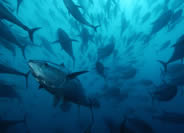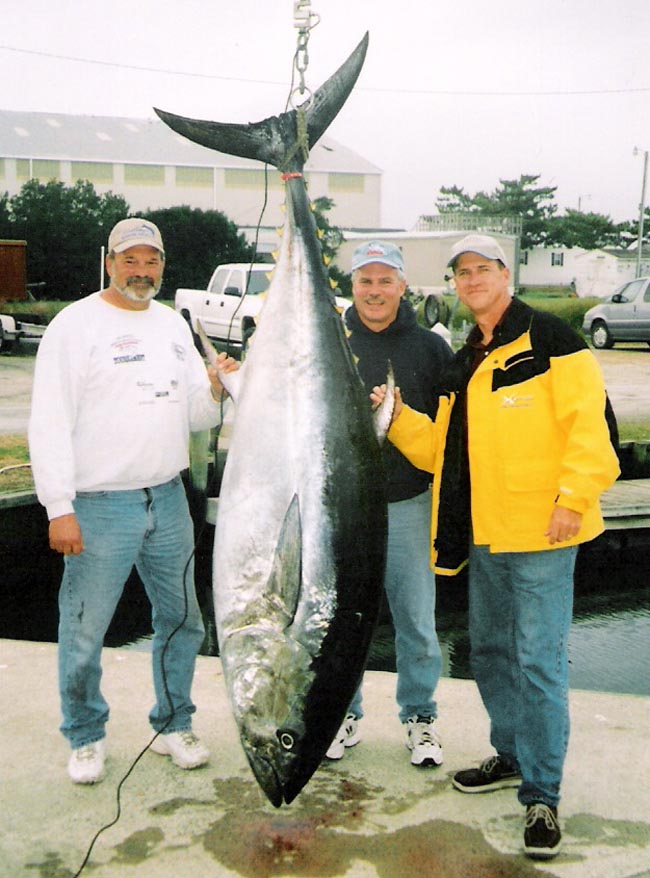Bluefin Tuna
 Biology 342 Fall 2010
Biology 342 Fall 2010
Lucy Sudekum and Colin Townes-Anderson
Adaptive Value
Adaptive value describes the function of the behavior as it applies to survival and fitness consequences in relation to its evolutionary background. It specifically looks at the utility of the behavior with regards to increasing the organisms’ reproductive success.
The success of the bluefin tuna in its ability to dive deep and sustain a warm body temperature through its trans-oceanic migrations can be attributed to its regional endothermy, the conservation of metabolic heat by vascular countercurrent heat exchanges. All other fish lineages that have evolved this trait, limned sharks, billfish, and tunas, are large, pelagic species with high-energy demands that are required to make long migrations and move vertically though water while experiencing a range of water temperatures.
Because of the tunas’ endothermic abilities it has been hypothesized that this evolved trait expands the tunas thermal niche, allowing the bluefin tuna to be able to move though thermoclines. However, more than just the development of endothermy would be required for niche expansion. The concurrent and convergent evolution of the ability to elevate slow-twitch, slow-oxidative locomotive muscle temperature suggests selective advantage of that trait. Although endothermy does not directly relate to increased aerobic swimming speeds, slow-oxidative muscle power, or energetic efficiency, it has been shown that endothermy is related to higher standard metabolic rates, possibly due to high aerobic capacities needed for such active fishes.
Tuna move in schools through chilling waters in order to avoid predators and find prey. Many vertebrate and invertebrate prey congregate within the cooler waters that the tuna pass through on their transoceanic migrations. Without endothermy the bluefins would not be able to reach their prey and subsequently not reach their spawning grounds (Fromentin and Powers 2005).
The evolution of endothermy as address by Dickson and Graham explains that it not only leads to an expansion of the thermal niche of the fishes, but also stabilizes tissue temperatures when ambient temperature changes, helps the fish perceive thermal gradients more effectively, and increases the rates of metabolic processes by allowing faster recovery from anaerobic bursts, and increases the rates of somatic and gonad growth. Specifically the thermal niche expansion hypothesis states that endothermy enables the Atlantic northern bluefin tuna, specifically, to greatly expand its range and take advantage of more extensive feeding areas in northern waters warm spawning areas in the tropics. (Dickson and Graham)
The cold tolerance of bluefin tuna allows it to expand its thermal niche deeper vertically in the oceans than closely related tunas such as the yellowfin tuna. In a study to examine the situ cardiac performance of Pacific bluefin tuna hearts in response to acute temperature change, it was shown that bluefin tunas’ cold tolerance may depend on sarcoplasmic reticulum proteins, that allows for higher rates of force development and relaxation. Improved cardiac performance in cold waters at cellular and individual levels may allow bluefin tuna to penetrate into cooler thermal niche. Considering that bluefin tuna live in cooler waters, maintaining the heart performance, allows bluefin tuna to dive deeper and for a longer duration than its closely related yellowfin tuna. (Blank et al) Not only is it shown that the tuna can withstand these chilling temperatures but it is shown that Pacific bluefin tuna actually travel faster when migrating through colder thermoclines than warmer ones.
While the endothermic ability of the tunas allows them to thrive in cold waters, they are also able to experience very warm water temperatures in their breeding grounds such as in the Gulf of Mexico. It is hypothesized that the reasoning for such an expansive (Kitagawa et al)

